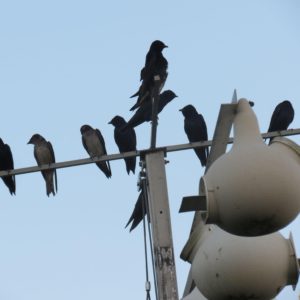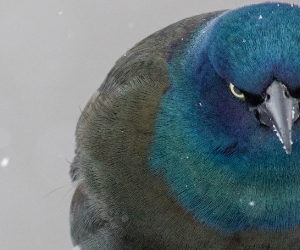IBA Caretaker Braves Storm to Make Observations
[two_third]
[separator headline=”h2″ title=”Charlie McPherson, Important Bird Area Caretaker for the Netly-Libau marsh IBA, is back as a guest blogger with an update on his latest bird monitoring efforts.”]
By Charlie McPherson
The Netly-Libau marsh at the south end of Lake Winnipeg is one of Canada’s nearly 600 Important Bird Areas.
The day of the storm started out nice and clear and we birder counters (Ray and I) were able to find some nesting colonies of terns and gulls on the Libau side (east side) of the marsh – about an hour’s travel from the west side from which we launched. We launched on the lake side of the beach ridge separating Lake Winnipeg from the marsh simply because access to the marsh through it’s river channels flowing into the lake is a whole lot easier from the lake than a marsh side launch which can often be too shallow or plugged depending on wind tides.
We travelled the maze of channels within the marsh doing bird counts as we went: a little hike along the south shore of the lake to the Salamonia Channel got us into the marsh, a 6 mile journey south got us to the centre of the marsh, a stop along the way to count and photograph an eagle nest with a juvenile Bald eagle got them on paper, another mile east and then north up the East Channel to it’s mouth and about a mile juant south and east across a bay got us to a fairly good bird count – terns, gulls, grebes, pelicans, cormorants, ducks, geese, even a few herons. A turn south got us a bigger bird count; a turn north again, east again, south again, more counts.
Forster’s terns, a trigger species which contribute in part to making this marsh an IBA, will go airborne if you approach one of their colonies. They’ll also dive bomb you, although vainly, in an attempt to drive you off. By going airborne the terns give you a bit of an idea of some of the numbers that are out there at that particular site at that particular moment. If there are two of you doing the counts, you can divide the sky in half. For example: Ray counted the birds in the southern half while I counted the birds in the northern half. We took special note to count the young of the year, most of which were already airborne and easily identifiable. Rather than disturb the nesting area right then (as some young were not airborne yet), we’ll go back when the birds are finished nesting and all of them are airborne for a more accurate count. We’ll also forge our way into the colony site, itself, once the area is abandoned and count nest sites.
When we saw the storm kicking up out of the west we abandoned the area ourselves and made a beeline back for our launch site. Lake Winnipeg cannot be trusted even for a minute when a storm is brewing so although a beeline along it’s south shore truly would have been a beeline, a return marshside was what it was going to have to be. We took “the short cut” back through the maze of channels: a mile or so north east, a bit west, a few miles south, a cross over west, and bit north, a mile or so west, a bit south, and then more west. We pushed it and made it to a little stretch of open water along the west edge of Hughe’s Lake ( a lake within the marsh) as you approach the Salamonia Channel on the west side of the marsh (about half a mile from where we had launched) when the storm hit and wouldn’t let us out. We were soaked in an instant. It was Ray’s baptism – no doubt about it – a first time ever journey into the marsh for him. I turned the boat around and headed straight into a large bed of cattails. There’s shelter within the cattails.
I carry a boat-sized piece of vapor barrier to protect myself, my birding buddies, my scope and my camera, etc., from wind spray when boating into even small waves on normal, nice day, birding occasions. As we were pulling the boat into the cattails, the wind sucked that sheet right out of the boat and sent it flying towards Libau. Oh boy! It landed about 50 yards into the cattail bed. I knew it could make a difference to our weathering the storm, immediately dropped everything and went dashing through the cattails to retrieve it before the wind could suck it back up and actually carry it to Libau, or Ontario for that matter. All Ray could do was wonder. There I was helping him haul the boat into the cattails and suddenly I had disappeared into them chasing down that tarp. Thankfully, I did manage to get it. We set our boat-birding lawn chairs (we do bird comfortably) into the shelter of the cattails, tucked the edge of the plastic sheet under the back legs, pulled it up over top of us, and sat it out.
Did we ever get pelted. It poured sheets of rain. We were already wet, so had we not had the plastic we wouldn’t have gotten any wetter, but the plastic did protect us from the pelting, and added to the cattail shelter, and blocked some of the wind that howled over top. We could have turned the boat over and jumped under had I not been able to retrieve the plastic, or had it hailed, but none of that happened. We were safe! The temperature was warm so we weren’t cold. When all was said and done and the storm had moved on, I pulled out my campstove and surprised Ray with a warming cup of coffee. We had to bail a foot of water out of the back of the boat before heading out again and once that was done, we were on our way. The turbulence in the Salamonia Channel where marsh draining current meets wind driven lake tide was something else…
I found a baby Robin shivering to death upside down in the sand along the lakeshore when we reached our landing. I guess the storm had blown it out of its nest. I couldn’t find the nest. I was able to revive it on the journey home – simply cupping it in my hands and blowing hot breath onto it to dry it up. Dog food and hard-boiled eggs have the right protein content for birds like robins if you ever have to nurse one for whatever reason. If you can find a robin’s nest with young the same age as the bird you nurse, you can introduce it to the nest. Robins will adopt.
There`s a game bird refuge just under the beach ridge, north mid marsh. It was created to keep ducks and geese around a bit longer throughout the hunting season so hunters would have a better chance of bagging a few. A good hunter who knows what he`s doing can shoot a marsh out in no time, and game birds will abandon a marsh if they are constantly being shot at, hence the refuge. The true refuge for this marsh, though, should be the north east quarter. This quarter holds, by far, most all of the populations of breeding marsh birds. Proximity to the lake (fish food), the beach ridge (trees and solid ground), plus shallowness of the intermarsh lakes in that corner (mud flats, weeds) are the reasons. All other marsh lakes are too deep (3 ft. average), or too prone to wind tides due to lake regulation for the production of electricity, to support a food chain. Draw this marsh down and the food chain would return, as would the hundreds of thousands of ducks, geese, frogs and muskrats; and the thousands of terns, gulls and grebes – the numbers our forefathers used to see.
Charlie is part of a network of over 200 volunteers who watch over and protect Important Bird Areas across Canada. As the national sponsor of the Important Bird Area Caretaker Network, TransCanada Corporation committed $1 million in 2009 to support bird conservation efforts in Canada over the following five years. Find out more about the IBA Caretaker Network and how to become a Caretaker here.
[/two_third][one_third_last]
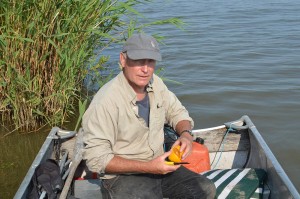 Charlie McPherson in his boat at Netly-Libau marsh, Manitoba
Charlie McPherson in his boat at Netly-Libau marsh, Manitoba
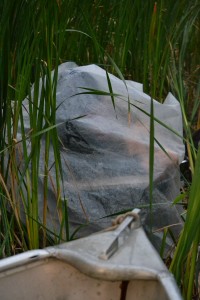 Charlie and Ray sit under tarp.
Charlie and Ray sit under tarp.
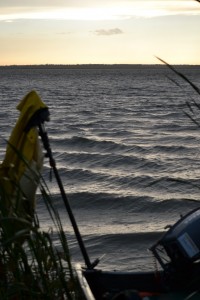 After the storm
After the storm
[/one_third_last]

